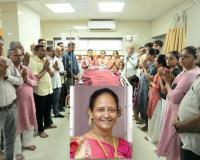Fafda-Jalebi Tradition in Surat Expands with Kathiyawadi and Rajasthani Flavors

Surat – In the city’s breakfast culture, fafda holds a special place alongside khaman-locha and jalebi. Its demand multiplies on Dussehra when the tradition of eating fafda-jalebi becomes almost synonymous with celebration. Once dominated by the original Surti fafda, known for its long, finger-shaped form and crunchy texture, Surat’s growing cultural mix has now introduced Kathiyawadi and Rajasthani varieties to the platter.
As per report, the specialty of Surti fafda lies in its length, crispness, and the distinctive flavor created by a careful blend of gram flour, carom seeds, and asafoetida. Skilled artisans use traditional techniques to prepare it, but with demand outpacing the limited number of experts, both its price and prestige have risen significantly.
With the rising Saurashtrian population in the city, Kathiyawadi nylon fafda has also become a part of Surat’s culinary identity. Unlike the Surti style, these are wider and thinner, usually served with papaya sambhar, fried green chilies, and sweet chutney. The combination has won popularity not only among the Saurashtrian community but also with native Surti food lovers.
Adding to this variety, Rajasthani fafda has also carved a niche in Surat’s food market. Made by Rajasthani traders and artisans, this version uses more baking soda, giving it a texture that lies somewhere between Surti and Kathiyawadi fafda. Lighter in taste and easier to prepare, it has become another favorite option.
For food enthusiasts, especially during festivals, fafda in Surat is no longer limited to its traditional Surti form. The Kathiyawadi and Rajasthani influences now reflect the city’s evolving taste and highlight why Surat is often called the “Mini India” for its culinary and cultural diversity.






